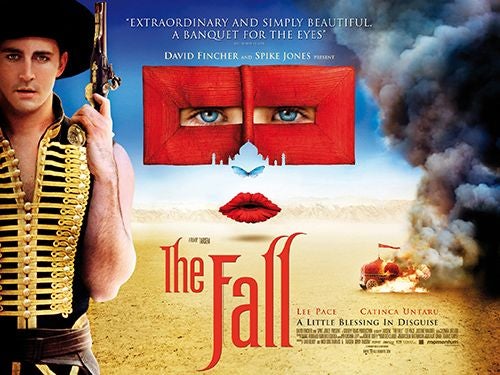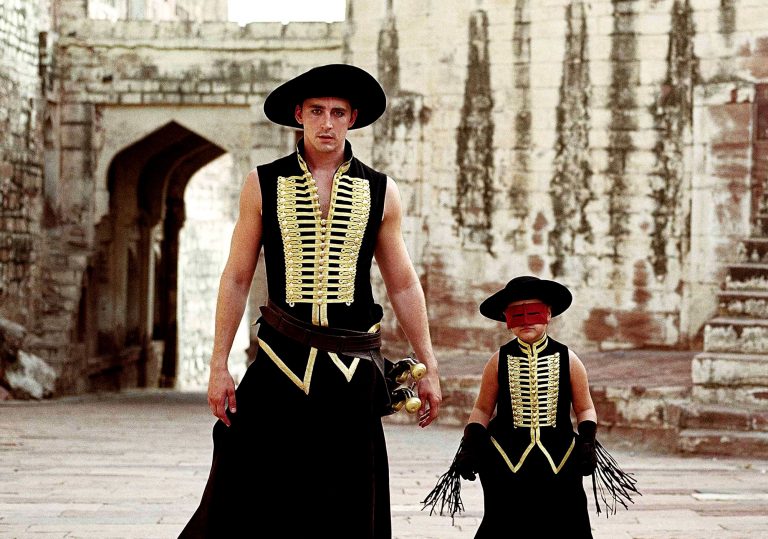Director: Tarsem Singh (Indian, Man)
I cannot think of a more fitting first review for a blog about de-centralizing white-framing than a movie that is quite literally about narrative frames. So here we are.
I've begun writing this the moment I could stop sobbing, so I guess you can keep that in mind as you read this. Clearly, I've been well and truly impacted, and I think this movie rather effortlessly fell (pun intended) into my list of favorite movies of all time.
The General Idea
The Fall revolves around the concept of storytelling. A stuntman named Roy (played marvelously by Lee Pace) is hospitalized, bedridden and potentially paralyzed. He meets Alexandria (played incredibly by young Catinca Untaru), a 5 year old who is staying in the hospital due to a broken arm. He tells her an Epic story, about love and revenge.
On Narration
We see the story through Alexandria's imagination. The world is vivid, colorful, magical, and as a result, accuracy is neither suggested nor needed. It's through the eyes of a child - so Singh had the opportunity to make it as wildly fantastical as they wanted, and they sure did so.
The narration, on the other hand, is by Roy. Since the literal narrator is not the visual narrator of the film, there are sometimes inconsistencies from Roy's words verses what we see. For example, Roy describes a man as "the Indian" - referring to a native American man. Alexandria sees her Indian co-worker, complete with a gorgeous green turban. That being said, it doesn't take long for Alexandria's ideas to start infiltrating the story, as she corrects Roy and interjects along the way.
The dialogue between the two of them is just stunning. A lot of this has to do with the fact that Catinca Untaru's part was largely unscripted. Lee Pace was in his hospital bed for the majority of the filming, to make Untaru's reactions more real as she believed that Pace may be paralyzed. In a rather infamous scene, she reads a word incorrectly, interpreting an E as a 3, which Pace and Singh decided to keep and play off, which contributes to a significant plot twist. As a result, Untaru is completely charming, and absolutely believable.
Can We Talk About the SET, or the lack of set?
One of the reasons why this film is so goddamn beautiful is because Singh didn't use any sets. Everything is filmed in real locations, with practical effects rather than CGI. His eye for color is pure artistry, and he utilizes it to maximum effect, filming in over 20 countries. The filming for the "fantasy" sequences took over four years as a result.
But seriously, just look for yourselves and you'll get it. To say that this is just a small snippet of scenes that made me audibly gasp is not an exaggeration.
Those COSTUMES though
The other thing that made me audibly gasp on a consistent basis is the costuming. Huge shoutout to Eiko Ishioka (Japanese, woman) who designed costumes that is an absolute feast for the eyes. This is one case of where the costuming not only looks incredible, but also adds to the narrative quality of the film. One little touch that I could not get over was how Alexandria wears her cardigan throughout the movie, with one arm in, the whole thing twisted to the side so that she can stick her cast out. Of course, the fantasy sequence costuming is really what you want to stare at for days.
Again, don't take my word for it.
(Roy and Alexandria, who has decided she has the same costume as Roy, obviously.)
(The main characters of the "Fantasy" setting. I particularly love the coat on the far left.)
(If I could own this dress, I would.)
(screaming)
Details, details, details
There's some heavy subjects in this movie. Death (in general), life-changing injuries, suicidal ideation, child labor, poverty, the (insane) risks that stuntmen took in the early days of Hollywood. The interactions that we as the viewer experience with these subjects are largely the way that Alexandria experiences them. This means simultaneously that sometimes she gets more than she can handle, and sometimes she gets a beautifully crafted message. I especially love the scene where an older gentleman gives her a "magic spell" to make fear go-away, which becomes a mantra throughout the film (and the soundtrack!). It is a, sometimes horribly, realistic conversation but it is treated with care.
One moment that I want to address without giving anything away could have been horribly traumatic, but they chose to explore the moment by veering off sharply into the avant-garde. We see seemingly unrelated shots of ice melting, scenery, and then sudden stop motion animation. I think that it was the perfect choice for the situation, fully delivering the emotional content without visually accosting the audience. I would love to see more movies take risks like this, delivering a more artistic and emotional scene rather than going for a gory-gut punch.
TLDR:
Visually stunning, emotionally powerful, with moments of pure joy and moments that made me bawl like a baby. This film makes us question whose story we are listening to, whose eyes we are seeing through, and which voices should be heard. Sometimes it is better to listen than to tell the tale.






No comments:
Post a Comment